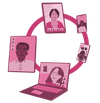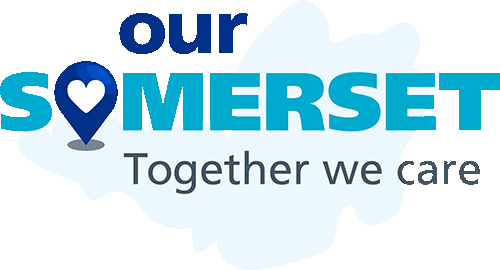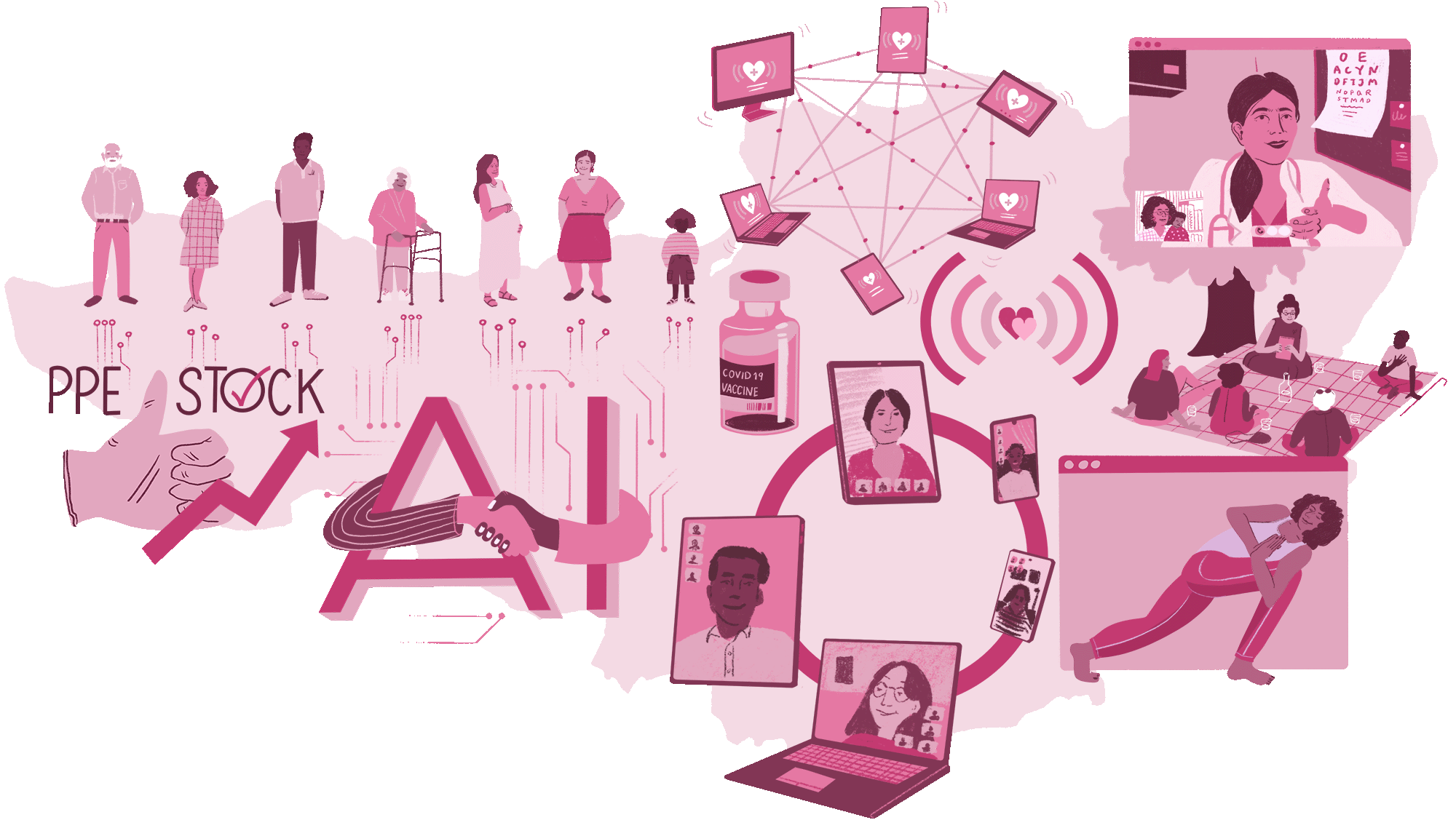Introduction
The Networked Health and Care system describes a reality in 2035 where there has been massive investment in the NHS and partnerships with the private sector. Great advances in e-health have been rolling for a decade resulting from a proliferation of cheap technologies in personal health. This is a smart, technology-led integrated health service which is networked, uses big data effectively to target treatment developments and is led by the central government.
Older people are happily benefiting from cheap e-health aids and adaptations, including technology to identify early potential illness. In this world there is a net increase in the workforce through virtual health care roles, Artificial Intelligence (AI) and a range of new specialist clinical and technology roles. Health and care needs are no longer viewed as a burden on society or a drain on public resources; health and care needs are now viewed as a tech design opportunity, a source of investment and stage of life' markers which are both normal and predictable.
What will it be like in 2035?

Those living in rural areas in the South West, including Somerset, will access tech driven treatment and low cost health monitoring devices.

A 'consultation' through an AI interface will be a routine way to raise health concerns, in the first instance.

Pharmacists will provide online consultations, and track medication and repeat prescriptions remotely.

Investment from government and private sector as well as life sciences and clinical research and development will be closely aligned.

Mental ill-health of the population will be continuously scanned by using low-cost technologies which will monitor sleep and mood patterns amongst other areas.

Care is distinct from health. Human and relational aspects of care are now the domain of 'Community People', a successful South West regional social enterprise that is commissioned alongside technical services as needed, with the aim of supporting communication, isolation and socio/mental wellbeing in what is now a technical health industry.
A view from 2035
Today in 2035, the NHS is a national, technology-driven and networked system of care, and Somerset and the South West Region as a whole benefits greatly. In the 2023-2028 Somerset ICS Primary Care Strategy, Chief Medical Officer Dr. Bernie Marden wrote “While there is no single easy solution, a well-designed and executed programme of clear and decisive actions that attend to the causes of our current challenges will improve the situation significantly.” This ‘solution-focused’ commitment has yielded many positive results now in 2035.
Since the Covid-19 Inquiry which made a faltering start in 2022, the government has invested heavily to create world class care for major health problems for everyone across the South West, including the prevention of heart attacks, strokes and dementia cases, providing education and exercise programmes to tens of thousands more patients with heart problems, preventing premature deaths and saving many more lives each year by diagnosing more cancers early. Addiction services have been shored up through new tech driven responses to monitoring and behaviour change and the link between Mental Health, addiction and physical health has been prioritised as a diagnostic service with early warning signals based on annual physical online checks.
Politically, it was finally realised after the pandemic of 2020/21 and the impact of industrial action in the health service in 2023 that under investment year-on-year to meet growing demand could not go on forever. Something had to give. Brexit gave the government confidence to act, to negotiate multi-million pound deals with private health care providers and to be unapologetic about the often commented upon UK mindset of exceptionalism which became increasingly harnessed as a driver for future success on the global digital health care stage.
Politically, the early part of the 2020s initially saw a continued movement towards a populist and often divisive approach to complex problems, but as the decade progressed, a move towards a blend of social, collaborative and compassionate politics led to increased opportunities to seek more diverse solutions to health. Global politics and economic stability emerged following the capitulation of the Russian forces in Ukraine in 2024, and by the mid to late 2020s, a period of hope and relative prosperity had developed across the western world. Pressures can still be felt with unexpected events' such as flooding, heatwaves and unprecedented winter conditions, all requiring an immediate response, but governments' commitments globally to reducing carbon emissions have created a more optimistic if still uncertain future.
The biggest and most radical development in health care over the last fifteen years has been the government-backed scheme to ensure that all citizens have their genome sequenced and since 2030 this has meant that clinicians can target the most effective treatments for their patients. The dual focus on precision treatment of disease and more tailored health promotion is prolonging healthy lives. “Personalised medicine for the masses” as one newspaper headline described it in 2029.

First talked about in the Health and Care Act of 2022, the opening of the National Health Information Technology Centre in Manchester in 2028 was seen as a driving force in shifting towards the effective use of big data. Funded by government and private finance, population health data is constantly collected, analysed and shared across the regions, transforming health care, informing clinical research and protecting the public.
Sharing of information at a local and national level, between government and the private sector and between patients and providers has enabled this connected, intelligent system to work. In 2023, there were significant concerns raised regarding AI and its potential to cause harm and create dangerous situations. However, governments responded to this on a global basis and put in place effective regulation which mitigated the dangers, focusing instead on the remarkable opportunities and possibilities it opened up. Its use in health and care is subject to strict conditions overseen by the World Health Organisation. People are at the heart of AI - it is a tool that requires specialist skills and an understanding of human emotions and conditions for it to have optimal impact.
It remains that whilst online security walls are now highly sophisticated and security protocols are policed by the new Global Web force, nevertheless occasional breaches in confidentiality and data protection do happen. But society has become used to this side effect of what is an otherwise welcomed sense of global interconnectivity, so much so that private insurance to protect against identity fraud and data attacks is now a mandatory clause in all home insurance policies.

A decade of breakthroughs in machine-learning have had a profound impact on how people are diagnosed and treated in the South West. Ironically, and perhaps unexpectedly, AI has been at the core of driving digital inclusion for those to access effective health and care services that in the past were traditionally excluded. Clinicians have access to more data than ever about the patients they serve, with virtually all citizens regularly capturing and sharing their monitoring data through smart phones and other devices as they work, rest and play. Clinicians can immediately access all previous scans and test results on any patient under their care, wherever they are.
Somerset was always ambitious in using digital to transform the workforce and the impact on outcomes. The Somerset ICB Workforce Plan of 2023 stated: “Digital transformation will have a significant impact on our workforce, in relation to strengthening digital skills and capabilities as well as introducing new models of care driven by digital transformation and releasing productivity gains. Digital transformation will support the shift towards community and home based care, providing remote technology that empowers service users and carers to manage their conditions and interact with clinicians more effectively. The new Electronic Health Record will reduce the overall number of systems used and improve communication.”
It was this determined approach that set in motion the direction of travel we now see in 2035.
Digital health profiles are now held for every citizen in Somerset and the wider South West, and are shaped by both clinical interactions, tests, consultancies and lifestyle choices as captured by an increasingly digitally enhanced society e.g. through QR codes in restaurants and online shopping.
Social inclusion has become a strategic driver for change both politically and economically as the social and monetary cost of exclusion post pandemic threatened to overwhelm public services in the late 2020s. Today, Commissioning from the Margins' - a new NHS programme to collaborate with marginalised individuals and groups - has become an established strand of the South West digital strategy, ensuring that previously marginalised communities and individuals in need are able to engage fully with the opportunities of the digital reform of health care.
In 2035 a pilot scheme to insert digital transmitters into human fingers finally achieved ethical approval and the services across the South West became a first wave test group in England. This allows huge amounts of medical and lifestyle data to be captured through a simple digital data recorder inserted under the skin which is activated when it connects with approved Bluetooth signals from companies and services who have joined the scheme. The incentives to join the scheme are very attractive and the pilots have all been overwhelmed by demand meaning that a broad range of data capture is becoming possible.
The social contract between individuals and data analyst companies has now shifted to an acceptance of the intrusion of online marketing and data profiling as the price to be paid for personalised products and wellbeing resources alongside the additional income source that data transmitters generate for Health and Social Care provision through advertising contracts.
All this data is sent to the National Health Information Technology Centre. M-care has been rolled out across the South West Region including to patients with terminal cancer and life-limiting conditions. To ensure wide uptake everyone over 75 became eligible for free wifi from 2025. However, the Somerset-based Cancer Support Charity, has criticised the lack of adequate emotional support and advice to help people cope with the side effects of drugs, meet wider needs and come to terms with their condition.
In Somerset, the Mental Health Alliance of the early 2020s recognised the need to provide support for people struggling with poor mental health. Communities across the South West have reported for many years that people feel more socially isolated and lonely, lacking human contact, but others find it easier to navigate all the online options for health care.
The recent introduction of human digital transmitters has caused some concern in the community, not least because of the payment incentives offered to trial volunteers, but most people when asked are positive about the data collection advances and want to be part of contributing to new science - a legacy from the multiple trial and ONS survey participation of the general public in 2021.

Patient leaders groups and experts by experience have seen an upsurge of membership as individuals seek out others with similar experience to connect with at a human level. Funding for virtual lived experience groups and chat rooms has been expanded and some local fundraising for face-to-face groups has allowed people to meet in person to share experiences. Experts by experience training is now focused on enabling access to IT and contributing to discussions in a virtual meeting environment.
The experience of children going to school in Somerset and the rest of the South West is dramatically different from what it was, even a decade ago. Augmented reality and AI have also made children's and young people's learning experiences in schools, colleges, universities more interactive and accessible. Technology is at the core of learning experiences, and also creates opportunities for shared experiences, socialisation and enhancing individual and collective wellbeing.
Today, demand for mental health services continues to be a significant consequence of the Covid pandemic and the subsequent cost of living crisis that affected the country. To meet this demand, South West innovators met in Somerset in 2024 to review the response of psychiatrists to traumatised service personnel after the first world war. They drew on the Northfield experiments which established therapeutic communities for people in distress and designed, at scale, Virtual Therapeutic Communities Plan for the South West population. The plan has begun implementation this year following an investment of £6 million for 3 years from the Central Government and includes the offer of 3 x 3 day in person stays per year at a venue in the beautiful Somerset countryside. The 3 day stay enables people with mental health difficulties to form a therapeutic community with 10 other people and is facilitated by a group therapist.

The therapeutic community then meets virtually every week with the same group therapist for the rest of the year. Members of the therapeutic communities already report high levels of satisfaction and improved wellbeing from this blend of in person and virtual work.
The Health and Care Act of 2022 set out a legislative framework to support the NHS deal with the yearly threat and pressures from new strains of Covid. That laid the way for mass investment in research and development and unprecedented use of technology. At the time, some commentators argued that the government was providing a legal framework for the NHS to sell the personal data of millions.
3D printing and virtual simulations create ways for patients to improve the personalisation, quality and safety of treatment and patient experience. 3D printing also offers faster prototypes and the creation of personalised prosthetics.
The government has invested heavily in low-cost technology and helps support those with complex or chronic conditions who are often prescribed mobile phones with preloaded apps to meet their assessed needs.
There was a rush early on of cheap apps being available purporting to provide quality healthcare, but which resulted in many cases of worsening health and in some cases death due to inappropriate self-care. There is now a kitemark governing approved apps. These apps provide relevant medical information, lifestyle advice and links to peer groups and other community-based groups to combat social exclusion. It is now standard practice for patients to wear monitoring type technologies.
Smart homes and sensors are popular and the promise of a good standard of care, without extortionate premiums or taxpayer burden, is enough to offset any of the doubts that people may have about their data being shared.
Today, physically seeing the doctor, however, is something that patients still do. With a population in Somerset that has risen to 612,000 by 2035, the technological developments in health and care have created a more efficient and effective response for citizens, making face-to-face consultation manageable.There are also a myriad of other ways in which the patient can make contact with those providing health advice and guidance. Personalised messaging is not uncommon.
Clinicians find themselves having closer relationships with large companies more than ever before, with corporate players including those developing pharmacy and other health care technologies offering close working relationships with NHS hospitals, doctors and other medical professionals.

Looking back, it is the successful roll-out of the Covid-19 vaccine in 2021 to the elderly and at-risk which is seen as marking a step-change in attitudes towards illness, age and technology. The vaccine - and its rapid deployment to those who most needed it - was soon seen as representing the ultimate triumph of human ingenuity in the form of technological breakthrough over seemingly intractable problems of illness and morbidity. The exhilaration and sense of achievement that followed drove the governments that followed to invest hugely in research and development aimed at tackling the other major sources of death and ill-health of our time, including cancer, dementia and heart disease - paving the way for the breakthroughs in mass genome sequencing which have radically altered the nature of health care in the South West by 2035.
Indeed, many of the South West's elderly citizens today feel a huge sense of gratitude towards younger generations both for the sacrifices they made during the pandemic era, and for their key role in bringing about the networked healthcare system responsible for prolonging the lives of so many today.
The South West - including relatively less affluent areas of Somerset such as Sedgemoor - has an increasingly burgeoning population of nonagenarians; these people were in at least their mid-70s at the time of pandemic, and still remember vividly the sense of terror and despair they felt during the darkest hours of 2020 and 2021. Since then, however, life for the elderly has been made progressively less scary and more dignified, thanks in large part to the accumulated impacts of one technological advance after another, as well as investment in care and mental health services since the pandemic.
That is not to say that absolutely everyone is delighted with the state of the South West's Health and Social Care services in 2035. Some residents - young and old - feel that euphoria over the vaccine and subsequent technological breakthroughs has overshadowed what should have been the main lesson of the pandemic, namely the heroic efforts of Health and Social Care workers and the vital importance of more traditional, human' care work. Some feel one of the main negative impacts of the pandemic in the long-term has been an inadvertent decline in the prevalence of face-to-face care - with some elderly citizens finding predominately virtual means of communication to be insufficient when it comes to staving off loneliness.
On the whole, however, most of the South West's younger and working-age population in 2035 feel just as satisfied and grateful regarding the networked healthcare system, as do the majority of the elderly. Those with chronic conditions are already aware of the benefits of the wide array of app-based and remote support now available; others, meanwhile, look forward to a future in which they too can experience the benefits of longer lives, and feel confident that they will be able to experience a high standard of care without this entailing excessive costs for themselves or for their loved ones.
One universally-acknowledged benefit of the growth of the networked healthcare system has been a diminution in the risk of a novel viral infection wrecking anywhere near the same level of societal destruction and harm as did Covid-19 fifteen years ago.

Firstly, NHS trusts and other providers across the South West now possess large stockpiles of smart PPE, aspects of which including breathability can be tweaked remotely depending on the precise nature of the infection being dealt with; leaders are confident that this would help greatly reduce transmission amongst Health and Social Care staff in any future epidemic.
Secondly, the prevalence of networked, health-related technology across the majority of homes in the South West has the potential, experts believe, to form the basis of a highly effective track and trace system should the need for one arise.
Lastly, and perhaps most importantly, scientists now feel certain that we possess the capacity to develop, test and deploy across the whole region an mRNA vaccine within a matter of weeks of any new pathogen emerging; a combination of confidence and technological capability which is emblematic of the transformed, networked healthcare system of 2035 in this scenario.
The role of leadership
In 2035 leaders are recruited, trained and rewarded for technical capability, ingenuity, networking skills and ability to work with detail and nuance. Communication skills are highly valued and musicians, linguists and mathematicians are often attracted into new health care roles as the required capabilities often suit the personality traits and attributes of these groups.
Clinical leaders are now trained in high spec digital skills and medical schools have by-and- large joined forces with IT and design companies to develop a curriculum based on product design and digital services.
Managers are few and far between as teams tend to work autonomously and on a project basis since most care happens in a virtual environment and alerts are mostly digital rather than in person. Managers are trained as super style administrators, often with only one or two staff employed to run large services. All managers now work from home as office space has become redundant in a digital environment. Staff training tends to be based on digital organising procedures and personal wellbeing to mitigate the potential isolation.
Groups of clinicians now work in laboratories with digital experts to collaborate on digital health solutions and as a result team working, collaboration and influencing skills are highly valued and rewarded. All graduate clinicians are exposed to a year in one of the top ten digital healthcare industry leaders before they are licensed to practise as clinicians. Many doctors take elective years and take study abroad semesters to broaden their exposure to global trends. The UK also benefits from the global transfer of digital thought leadership and the South West workforce is a diverse multi-lingual community of specialists.
Somerset and the South West Region as a whole has benefited from The University of Exeter expanding its North campus in 2028, and by 2035 is a global leader in environmental science and digital healthcare. The expansion into digital health allowed Exeter University to build on its existing top 10 research university status and combine its pre-existing conservation and environmental reputation with a new-found expertise in digital health care. This positioned the university as a leader in two of the most contemporaneous issues globally. Applications for undergraduates and post graduate courses soared. In collaboration with the Business school, a new Future Leaders programme has been established in 2030, jointly delivered with Ashridge in the UK and Harvard in the US. Graduates of the programme are regularly headhunted for top industry roles across the world.
Being a patient in the South West in 2035
Josh is 3 and lives in Somerset. Three months ago, after a bout of flu, his Mum suspected that something was amiss. She books an online consultation with a GP who advises her to buy a disposable blood glucose monitor from the chemist. It was a good spot. His blood sugar levels were over 20. Josh has Type 1 diabetes.
Josh spends some time in hospital to bring his diabetes under control. With the diabetes nurse, the family then has an online consultation with a specialist in London. He talks through the option of stem cell treatment for Josh. It's not a permanent fix, they are told, but human stem cells can be turned into insulin-producing beta cells within the pancreas. That would begin to work over the first two weeks and would last for a year. At that point, similar treatment could be given.
Josh's Mum looks relieved that something can be done and agrees to go through the e-diabetes learning package and if she is happy, an appointment for Josh to travel to London for initial stem cell treatment within the month will be arranged electronically.
Workforce profile - Somerset
Total workforce size in 2035
The Health and Social Care workforce has grown by just over a fifth in this scenario.
While past studies and the UK Government's 2023 NHS Workforce Plan had projected that services would require more staff than this to keep up with rising demand, the range of technological advances which have been successfully implemented in practice in the decade leading up to 2035 - such as, for example, the routine use of intelligent chatbots for initial consultations - have helped create a sense that levels of recruitment are indeed proving sufficient to meet the needs of people in Somerset.
The aspirations of the One Somerset Workforce' have yielded positive results, with the right skilled members of staff being evident from the new and modern ways of working. The transforming people services' agenda enabled by technology infrastructure and digital tools is clear to see in 2035. An agile, flexible and holistic approach to workforce skills that were not dependent on more traditional roles has led to a cultural shift and a workforce that is more agile and transferable in meeting the needs of the public. Somerset has attracted more new graduates and experienced staff than ever before due to the creative and forward thinking digital approach to health and care. In addition, there has been an expansion in the number of AHP-related roles to provide a more interventionist and holistic service for people across Somerset.
2023 saw the merger of the Trust Services across Somerset. This was a starting point for reviewing and improving the approach to workforce planning. Trailblazing approaches to Advanced Practice, Nursing Associate, Assistant Practitioner and other new roles to improve service delivery were at the core of workforce transformation programmes in 2023. Now, the workforce in 2035 also has a somewhat different composition in terms of roles than in the past, something which has also been driven by the large influx of technology-led interventions into the health service in recent years. For example, the rapid growth of app-based and remote support - including wearable monitoring technologies, smart' and sensory home support and apps through which patients can access online social and community support - has meant relatively fewer staff now work in more traditional' roles built primarily around face-to-face contact with the public. The nature of these roles has also been to some extent shaped and altered by technological developments - for example, a social care worker in 2035 spends a considerable amount of time helping patients adapt and make the most of new interventions aimed at improving their quality of life, including a range augmented reality-based supports designed to make it easier for patients to access information and activities relevant to their treatment from their homes.
Data is another area with regards to which the Health and Social Care landscape has been transformed since the early 2020s, with particularly important consequences for workforce planning. The vast amount of data concerning patient health now available to clinicians in Somerset, recent breakthroughs in areas such as machine learning, and the creation of digital health profiles for every citizen incorporating data on lifestyle choices, previous clinical interactions and genomic data have each helped create a situation in which it is possible to predict future need with impressive accuracy. This has enabled local leaders to view short, medium and long-term projections for different types of health needs with a specificity at the local level which would have been unimaginable in previous decades. As a result, the workforce now finds itself distributed across different roles and geographic locations in a highly efficient manner with regards to the main strategic priorities of the day, helping drive increased productivity levels across the workforce.
Finally, education and training in the healthcare sector in Somerset has also been dramatically impacted by the changes which have taken place in the decade leading up to 2035. Building on the role it played contributing to the whole genomic sequencing of SARS-CoV-2 in the early 2020s, the University of Exeter has become a key national leader in digital healthcare producing thousands of graduates each year with expertise across many different aspects of the networked, data-driven health system. While the University is of course a national and global institution, from which many graduates in subjects relating to digital healthcare leave to work in other regions and countries worldwide, the fact that it is located in the South West Region means it has had important consequences for the healthcare sector in constituent parts of the area, including Somerset. Many providers in Somerset, for instance, have partnership agreements with the University whereby practitioners and local system leaders can undertake short courses to update their skills and competencies with regards to the latest technological advances, while students at the university regularly spend time on placements across the Region to study the implementation and impacts of data-driven innovations in real-world clinical settings. Since the early 2020s, NHS Somerset's Digital Team has been involved with some new initiatives in the South West, spanning both Devon and Somerset. This collaborative approach to education and professional development has helped give the Health and Social Care system in the South West a reputation as being at the cutting edge of many aspects of the digital revolution taking place in Health and Social Care workforces across the country.
Fastest growing Health and Social Care occupation
324% increase since 2025
Initially a somewhat niche role, by 2035 there are nearly a thousand Innovation and Research Practitioners (IRPs) working in Devon. Their job is to ensure the services on the ground make successful practical application of the many data- and network-driven innovations developed by researchers at institutions such as the National Health Information Technology Centre. IRPs also play a key role in helping other parts of the workforce, including nurses and care workers, get to grips with new, tech-driven aspects of service provision such as m-Care. The role of the IRP therefore requires a blend of both clinical knowledge and data-related expertise with sufficient personal and communication skills. This enables IRPs to act as a bridge between more traditional Health and Social Care workers and the newer, specialist additions to the workforce in areas such as AI and virtual health care.
Other key trends
Overall, the various technological innovations put into practice since the early 2020s have had the effect of causing a decline in the levels of face-to-face contact experienced by many Health and Social Care workers; both with patients (due in part to the rise in use of virtual consultations and of app-driven personal monitoring techniques) and with colleagues (due in large part to the adoption of remote working for most administrative aspects of Health and Social Care work). While most workers recognise the benefits of many recent changes and express higher levels of satisfaction with pay levels than they have for several decades, some regret the loss of the human aspect' across much of modern healthcare, and feel physically isolated to a degree they would once never have thought likely in this field of work.
In addition to this, the need for doctors, nurses and care workers to regularly take part in training and digital upskilling exercises to maintain their capabilities regarding the newer, tech-driven aspects of their jobs has led to a sense of resentment amongst some (particularly older) members of the workforce. They believe that many of these innovations simply complicate their efforts to provide high-quality care. Some feel that the new additions to the workforce in research and development - often younger, and with backgrounds in natural science rather than on the ground in hospitals or in providing care - are too keen to push for the rapid implementation of new innovations before considering the full range of impacts they will have for healthcare workers and patients as a whole.
As an area, Somerset has thrived over the decade leading up to 2035. The nuclear power development at Hinkley Point-C, for example, has created significant employment for the area as well as bolstering a national and international perception that Somerset is at the heart of many technological and environmentally-conscious advances. Improved transport infrastructure resulting from a realignment of funding from HS2 into rural connectivity' has enhanced the train arteries between Somerset and the wider South West Region and the rest of England. Somerset has become an attractive option economically and socially for local citizens as well as talented people outside the area.
Staff survey results
Staff satisfied with their level of pay
up from 38% of NHS staff in 2019
Staff feeling unwell due to work-related stress in the past 12 months
40% in 2019
Staff feel that their manager takes a positive interest in their health and wellbeing
70% in 2019
Staff that often think about leaving their organisation
28% in 2019
Impact of Brexit on the workforce
By 2035, it is generally recognised that Brexit exacerbated workforce shortages in the South West's Health and Social Care sector up until the early 2020s, with a growth in negative perceptions of the UK on the continent reducing the desire of EEA residents to work and live here. However, Britain's success in delivering the first round of Covid vaccines to its citizens in 2021 (particularly in comparison to most EU countries) marked the beginning of a turnaround in the views of the UK amongst Europeans. In 2024, a renegotiation of the terms and conditions relating to Brexit between the UK government and the EU created a more flexible and dynamic partnership arrangement. Following the huge investments in public health and health-related research and development from the early 2020s onwards, this shift in perceptions gathered pace: today in 2035, most post-Brexit resentment towards the UK in Europe has been replaced by a sense of admiration (and even envy) for its innovative, dynamic and successful networked Health and Social Care sector.
This is partly the result of the high levels of cross-border collaboration involved in the work that goes on at institutions such as the National Health Information Technology Centre. Here, the work of European researchers is absolutely critical: the sustained post-Covid boom in remote and Zoom-based working has made collaboration between scientists of different nationalities more prevalent than ever before, regardless of whether they reside in the UK or elsewhere. The close involvement of European academics, scientists, and researchers in helping develop the technical advances now put into practice in the networked healthcare system has led many to feel more of a connection to the UK, despite increasing regulatory divergence between the UK and EU in fields such as agriculture. The French Health Ministry even recently produced a paper utilising the UK as a positive case study in making the case for public investment in health-related research and development to become a higher proportion of the EU's budget.
Workers from EEA countries are now more likely to be found in the South West Region in the new, data-related roles in the sector rather than in more traditional Health and Social Care occupations. The overall proportion of workers in the NHS and social care services in the South West who are from EEA countries has recovered since its post-Brexit nadir in 2022: this proportion has now been steady at around 7% for several years, an increase of around 1% since the time of the referendum.
The role of clinicians
- Lead clinicians have a deep understanding of patients' needs and how these interplay with the technical environment.
- Doctors provide an important bridge between the technologically driven service and the care that patients need.
- Doctors need a high degree of emotional intelligence to support patients with complex data about risk factors and to help them make difficult decisions.
- There is an increased emphasis on the development of technical skills to manipulate data and communicate risk effectively, alongside supporting self-care.
- Clinicians' roles emphasise the analysis being undertaken by Artificial Intelligence or specialists and given to doctors to interpret.
- The volume of data interpretation is heavily increased and used to enhance bespoke patient care.
- Global training programmes allow free movement across countries, effectively distributing the workforce.
- There would be an opportunity to make better use of technology to increase monitoring of the workforce to take breaks and introduce smarter rostering to improve shift planning.
- There is less intense working due to more algorithm-based diagnosis.
- Clinical teams have developed extensive understanding of moving resources (physical and virtual) around the system. Specialists are delivering services from a distance and at scale, for example, patient care and delivering training, as well as increased use of remote medicine (telemedicine).
- There are now more opportunities to diversify the range of health and care professionals and AHPs beyond clinician roles in meeting the needs of the public due to the advances in technological interventions and solutions.
How we got to 2035
Brexit and the United Kingdom leaves the European Union.
The Covid-19 pandemic impacts upon every citizen in Somerset and across the wider UK, with restrictions in England eventually fully lifted in February 2022.
Significant industrial action across the health system and the wider public sector in response to higher inflation, falling real wages and concerns around staff conditions.
UK Covid-19 Inquiry holds first public hearings.
2023 The UK Government publishes its NHS Workforce Plan, setting out independently-verified national-level projections for key job roles over the next 15 years.
General election - the incumbent government loses and opposition parties are invited to form a new Government on a platform to negotiate a new relationship with the EU and introduce a citizens’ income.
European Convention on Human Rights re-enshrined in UK law.
Free Wi-Fi for over 75s.
Regional devolution referenda are held and passed by popular vote across England, ultimately turning England into a more federal country.
Creation of waves of new technical jobs with the growing impact of AI.
Regional assemblies created across England, including the South West, with powers devolved to the local level, based strongly on the principle of subsidiarity. Regional elections held. Local activism and community-led citizen participation increases. The South West elects its first regional Mayor.
Opening of the National Health Information Technology Centre in Manchester shifting towards effective use of big data. The population's health data is constantly collected, analysed and shared across the regions, transforming health care, informing clinical research and protecting the public.
The UK joins the European Economic Area (EEA) (on a Norway-plus basis) after four years of intense UK-EU negotiations.
General election - a breakthrough number of Independent MPs representing community interests - building on the strength of their local/regional devolution platforms and supported by the newly enfranchised youth - are elected.
All citizens in the South West have their genome sequenced.
Regional assembly elections held.
General election, a Government is formed.

